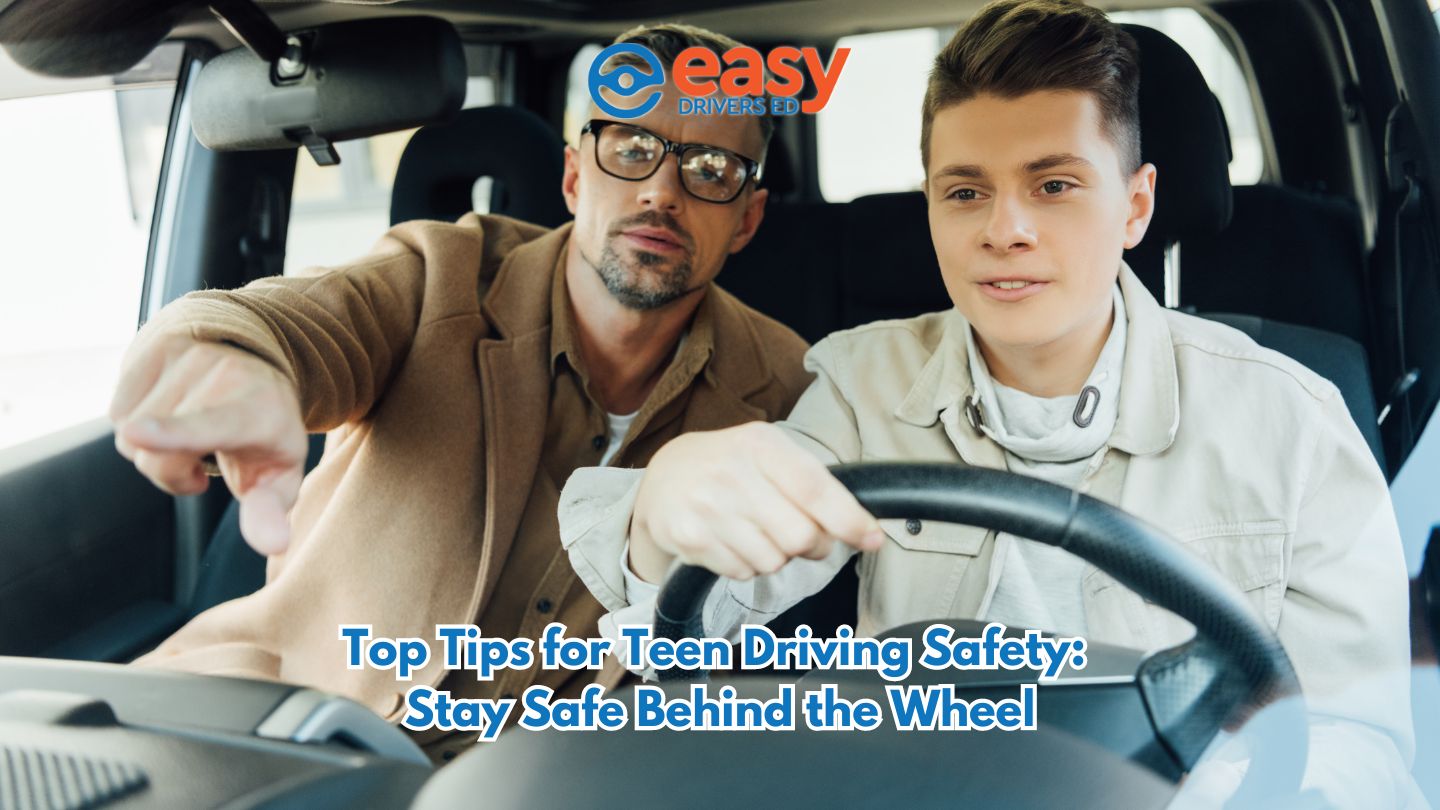Teen driving safety is crucial as car accidents are the leading cause of death among teenagers. This article provides essential tips on how to keep your teen safe, focusing on seat belts, managing distractions, and setting driving rules.
Key Takeaways
- Teen drivers face high crash risks due to inexperience, distractions, and speeding; establishing clear rules and supervised practice can enhance safety.
- Wearing seat belts is vital for both teen drivers and passengers, with statistics showing it greatly impacts survival in crashes.
- Utilizing technology and enrolling in driver education programs empowers teens with essential skills, promotes accountability, and fosters safe driving habits.
Understanding the Risks for Teen Drivers

Drivers in their teenage years are considerably more susceptible to being involved in car accidents compared with individuals from other age demographics. Approximately six teenagers succumb to injuries sustained in motor vehicle crashes each day, and countless others sustain injuries. These incidents constitute the most common cause of mortality for individuals between 15 and 20 years old, highlighting the necessity to tackle unique issues faced by adolescent drivers.
The high incidence of collisions among young drivers can largely be attributed to a lack of driving experience. Novice drivers often do not possess adequate proficiency to handle intricate traffic scenarios effectively and are prone to committing severe mistakes when behind the wheel. Factors such as using a cell phone while driving, yielding peer pressure, and neglecting traffic signs play an extensive role in these mishaps. The likelihood of crashing escalates twofold or even threefold when teen passengers accompany the driver due to increased distraction caused by peers.
Excessive speed also plays a crucial role in vehicular mishaps involving teens at the wheel—about one-third (32%) of fatal accidents that include drivers aged between 15-18 stem from speeding violations. As teens accumulate more hands-on driving time, overconfidence may set in, leading them to overlook speed regulations, thus amplifying accident risks.
To mitigate these dangers associated with youthful motorists taking command at the steering wheel, parents should step up efforts emphasizing regulated supervision during practice drives and fostering responsible automobile operating disciplines within their offspring.
The Importance of Seat Belts

Securing oneself with a seat belt is an uncomplicated yet exceptionally effective form of protection during vehicle collisions. Not only do they preserve lives, but they also greatly diminish the impact and injuries that can occur in such events. It’s concerning to note that numerous teenage drivers, along with their passengers, often disregard this safety measure, resulting in devastating outcomes. In fact, data from 2021 indicates that 51% of teen drivers who succumbed to crashes were not restrained by seat belts.
The influence of wearing a seat belt goes well beyond just safeguarding the driver. Its benefits extend to everyone on board the car. An alarming correlation exists where if a teenage driver neglects to buckle up, there’s a staggering 90% chance that any accompanying passengers who lose their lives will be found without their seat belts as well. Such statistics underscore how critical it is for young motorists to adopt strict regulations like enforcing mandatory buckling up for all inside the car; these steps are imperative when striving towards enhanced security measures among adolescent operators.
Parents stand at the forefront when it comes to instilling diligent use of seat belts among teens before setting off on any drive – regardless of trip length or destination proximity. Cementing this practice early into adolescence can lead significantly toward bolstered protection standards both for youthful chauffeurs themselves as well as those riding alongside them within vehicles.
Read more: How Much Can You Pay for Speeding in Texas?
Managing Distractions
Distracted driving ranks as a top cause of crashes involving teen drivers, and enhancing focus on the road can substantially improve overall safety. Teens are advised to input GPS routes prior to departure, thereby decreasing device handling during travel. It is recommended that teens refrain from consuming food while behind the wheel to maintain undivided attention on driving.
Reducing the count of passengers in the vehicle may also mitigate distraction levels for teenage motorists. Peer pressure plays an influential role in diverting a driver’s focus. Hence, limiting passenger numbers contributes to fostering a more serene environment within the car than one surrounded by multiple occupants.
It is crucial for teens to resist engaging in text messaging, conducting phone conversations, or browsing social media when operating a vehicle. By dedicating complete concentration to navigating their surroundings safely, young drivers can significantly diminish the risks associated with distracted behaviors leading to potential accidents.
Setting Ground Rules for Safe Driving

Establishing clear rules for driving safety is crucial in mitigating the risk of crashes among teenage drivers. It’s particularly effective to restrict the number of non-family peer passengers when teens are newly licensed, as their presence can increase accident risks two or threefold. Implementing such passenger limits can greatly improve road safety for these young drivers.
Creating a driving contract that outlines precise guidelines and repercussions helps hold teens accountable while encouraging safe practices on the road. This pact may stipulate prohibitions against using cell phones during driving, require adherence to established speed limits, and insist upon seat belt usage at all times. Engaging in candid conversations about responsible driving behaviors also acts as a deterrent against prevalent risky actions like speeding—a common issue with teen drivers.
Consistently reiterating and reinforcing these regulations ensures that teenagers adhere to them reliably. By defining transparent expectations and providing ongoing mentorship, parents play a pivotal role in cultivating sound habits behind the wheel for their adolescent children—habits expected to endure well into adulthood.
The Role of Supervised Driving Practice

Teens acquiring the necessary skills to navigate a car safely is pivotal, and it begins with supervised driving practice. This oversight affords them invaluable hands-on experience at the wheel, which elevates their confidence levels and equips them to face diverse driving situations. The synergy of methodical instruction alongside tangible behind-the-wheel exposure is instrumental for teens in establishing sound driving practices.
It’s recommended that adolescents accumulate between 30 and 50 hours of guided practice in a vehicle over a span of no less than six months. Such an extensive duration allows for exposure to various vehicular operating conditions and scenarios, ensuring they are better equipped for independent driving. Following completion of the mandatory online classroom curriculum spanning 32 hours, students may then progress to actual on-road training sessions.
The integration of observed practical lessons, along with active participation within the car, greatly enhances learning outcomes regarding vehicle control expertise. It’s imperative for parents to participate actively in this phase by offering direction and support as young drivers learn how intricate managing an automobile can be.
Dealing with Drowsy Driving
The danger of drowsy driving is a considerable hazard for teen drivers and their fellow motorists. Maintaining a consistent sleep routine helps ensure that teens acquire sufficient rest, thereby diminishing the likelihood of experiencing drowsiness behind the wheel. The dangers presented by drowsy driving are on par with those associated with impaired driving due to alcohol consumption, underscoring the importance of treating this concern with utmost seriousness.
It is vital to educate teenage drivers about the risks inherent in drowsy driving and assist them in recognizing fatigue symptoms. Should a teen feel exhausted, it’s essential they refrain from operating a vehicle and seek alternative modes of transport instead. By emphasizing the need for ample rest and vigilance, teens can make decisions that enhance their safety when driving.
Educating About Impaired Driving
Driving while impaired is a severe problem that drastically raises the risk of vehicular incidents, with teenagers particularly at risk. A notable portion of younger drivers involved in fatal collisions have been found with alcohol levels indicative of impairment, underscoring the perils tied to drinking and driving. The importance lies in educating teenagers about the consequences of such behavior to avert these calamities.
Teens are more susceptible to becoming drivers under the influence when they indulge in underage drinking or accept rides from those who have been drinking. By fostering open dialogues around hazardous scenarios, teens can be better prepared to ask for assistance when confronted with situations involving impaired driving. It is crucial for them to learn it’s preferable to get help rather than choose to operate vehicles while compromised—a decision that could prove lifesaving.
Comparable dangers present themselves with drowsy driving, an issue similar in severity to drunk driving risks. Teenagers often suffer from a lack of sleep, which exacerbates their vulnerability to fatigue behind the wheel—increasing their likelihood of accidents due to drowsiness during travel times. Advocating sufficient rest before embarking on any journey and instilling awareness regarding impaired and drowsy operation practices among youth can contribute greatly towards enhancing safety measures on roads for everyone involved.
Speeding and Traffic Signs
Speed limits are a critical aspect of road safety, especially for teen drivers. The likelihood of an accident increases when additional passengers are present in the vehicle with a teenage driver. Adherence to speed limits is vital as it’s a primary contributor to accidents on the roads. Encouraging teenagers to plan ahead and depart sooner for their destinations can help curb the urge to exceed these limits.
Comprehension and compliance with traffic signs also play a significant role in ensuring teens drive safely. These signs convey important directives and information that uphold orderliness and security while driving. It’s imperative for teens to be well-versed with all traffic sign meanings so they can make informed decisions behind the wheel.
Parents have technology at their disposal, which can bolster safe driving habits among teens. Applications such as MamaBear provide real-time alerts whenever teenagers speed up or enter unauthorized zones, offering parents another means of monitoring safety measures effectively. Such technological solutions empower parents to hold young drivers accountable, thus nurturing responsible conduct when operating vehicles.
Preparing for Different Weather Conditions
Adolescents must be ready to face the various challenges that come with driving under diverse meteorological situations. Gaining experience behind the wheel across a range of conditions can bolster their confidence and skill set, preparing them for unforeseen events. When the weather turns foul, the danger associated with speeding is magnified, emphasizing the need for judicious management of vehicle speed.
When roads are drenched by rain, it’s important for young drivers to reduce their velocity in order to increase their stopping distances and diminish the risk of skidding on slick surfaces. Employing smooth motions when accelerating or braking is also essential in retaining control during wet weather drives. To prevent hydroplaning incidents, youths should lower speeds. And ensure that tires have adequate tread.
Conscientious upkeep of tires—checking both inflation levels and tread wear—is crucial when aiming for optimal safety while operating vehicles amid inclement weather patterns. Keeping windshield wipers in working order enhances visibility just as effectively utilizing headlights does amidst rainfall. These measures significantly contribute to safer travel. Teenagers equipped with knowledge about how different weathers impact driving will find themselves more adept at steering through challenging road conditions confidently and securely.
Utilizing Technology for Safety

Leveraging technology can serve as a significant support in enhancing the safety of teen drivers. There are numerous applications designed to track and analyze the driving patterns and conduct of teenagers, offering critical feedback on their vehicular habits. It is essential for parents to employ these monitoring tools openly while establishing explicit expectations regarding their teens’ driving behaviors.
Employing technological solutions can aid in cultivating more secure driving techniques by pinpointing specific areas where improvement is needed and emphasizing positive driving practices. Promoting honest communication regarding the use of such technology for driver surveillance can play an instrumental role in building trust and responsibility between parents and their teenage children.
Through these measures, families have the opportunity to work together toward creating a safer environment on the road for teen drivers.
Enrolling in Driver Education Programs
Educational programs dedicated to driving are pivotal in imparting critical knowledge and skills for road safety. These instructional courses emphasize defensive driving strategies, which play a vital role in safeguarding teen drivers. By participating in an extensive driver education program, teens can markedly lower their chances of being involved in accidents through mastery of the safe operation of vehicles.
Teens have the advantage of fitting their study schedules around personal commitments thanks to online driver education options that allow for self-paced learning from any location. The added benefit is that many web-based courses facilitate immediate certificate issuance upon course completion, enhancing ease and efficiency.
A commitment to robust training offered by driver education is beneficial not just for acquiring elementary driving maneuvers but also for fostering a commitment to lifelong prudent driving practices among adolescents.
Summary
To guarantee the safety of teen drivers, a comprehensive strategy is essential. This includes recognizing potential dangers, insisting on seat belt usage, minimizing distractions, and establishing basic rules for driving behavior. It’s imperative that teens engage in supervised practice behind the wheel and learn to navigate issues such as drowsiness and impaired driving while also respecting speed limits and obeying traffic signs.
Parents can bolster their teens’ ability to drive safely by preparing them for various weather scenarios, leveraging technology designed to enhance safety features in vehicles, and ensuring they participate in Texas parent taught drivers Ed courses. It’s critical to understand that a substantial investment in your teen’s driver education, combined with setting clear boundaries, can profoundly influence their level of road safety.
Easy Drivers Ed Services
Easy Drivers. Ed delivers an accommodating online driver education platform, which is especially advantageous for teenage learners in Texas, including those seeking driver ed in Houston, Texas. The flexibility of these courses means that students can progress through their driving lessons at any chosen location, offering a more adaptable solution than traditional in-person driving schools.
Ready to hit the road with confidence? Contact us today and take the first step towards becoming a skilled and safe driver.
Frequently Asked Questions
What is the benefit of taking drivers education online in Texas?
Taking driver’s education online in Texas offers the convenience of learning from anywhere and at your own pace, making it easier to fit into your busy schedule.
Embrace this flexible option to become a confident driver!
When can you start online driver education in Texas?
You can start online driver education in Texas as soon as you meet the age requirements.
Don’t wait—get started on your journey to driving today!
What is one of the key focuses of the Texas drivers education course?
One of the key focuses of the Texas drivers education course is teaching defensive driving techniques and safe driving tips to ensure you’re well-prepared for the road.
Embrace this knowledge for a safer driving experience!
What is the cost of Parent Taught Drivers Ed in Texas?
The cost of Parent Taught Drivers Ed in Texas is $60.00, making it an affordable option to help your teen gain driving skills effectively.
Investing in this program is a smart step towards their independence!
How can students take the driving permit test?
Students can take the driving permit test online from home, which makes it convenient and accessible.
Just ensure you follow your state’s guidelines for registration and testing!

